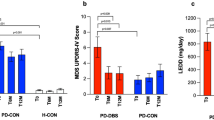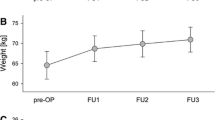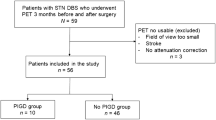Abstract
Parkinson’s disease is a common neurodegenerative disease that can be treated with pharmacological or surgical therapy. Subthalamic nucleus (STN) deep brain stimulation is a commonly used surgical option. A reported side effect of STN-DBS is weight gain: the aim of our study was to find those factors that determine weight gain, through one year-long observation of 32 patients that underwent surgery in our centre. During the follow-up, we considered: anthropometric features, hormonal levels, motor outcome, neuropsychological and quality of life outcomes, therapeutic parameters and electrodes position. The majority (84%) of our patients gained weight (6.7 kg in 12 months); more than a half of the cohort became overweight. At 12th month, weight gain showed a correlation with dyskinesias reduction, electrodes voltage and distance on the lateral axis. In the multivariate regression analysis, the determinants of weight gain were dyskinesias reduction and electrodes position. In this study, we identified dyskinesias reduction and distance between the active electrodes and the third ventricle as determining factors of weight gain after STN-DBS implantation in PD patients. The first finding could be linked to a decrease in energy consumption, while the second one could be due to a lower stimulation of the lateral hypothalamic area, known for its important role in metabolism and body weight control. Weight gain is a common finding after STN-DBS implantation, and it should be carefully monitored given the potential harmful consequences of overweight.



Similar content being viewed by others
References
Amami P, Dekker I, Piacentini S, Ferré F, Romito LM, Franzini A, Foncke EMJ, Albanese A (2015) Impulse control behaviours in patients with Parkinson’s disease after subthalamic deep brain stimulation: de novo cases and 3-year follow-up. J Neurol Neurosurg Psychiatry 86:562–564
Bannier S, Montaurier C, Derost PP, Ulla M, Lemaire J-J, Boirie Y, Morio B, Durif F (2009) Overweight after deep brain stimulation of the subthalamic nucleus in Parkinson disease: long term follow-up. J Neurol Neurosurg Psychiatry 80:484–488
Barichella M, Marczewska AM, Mariani C, Landi A, Vairo A, Pezzoli G (2003) Body weight gain rate in patients with Parkinson’s disease and deep brain stimulation. Mov Disord Off J Mov Disord Soc 18:1337–1340
Barutca S, Turgut M, Meydan N, Ozsunar Y (2003) Subthalamic nucleus tumor causing hyperphagia—case report. Neurol Med Chir (Tokyo) 43:457–460
Baunez C, Amalric M, Robbins TW (2002) Enhanced food-related motivation after bilateral lesions of the subthalamic nucleus. J Neurosci 22:562–568
de Chazeron I, Pereira B, Chereau-Boudet I, Durif F, Lemaire JJ, Brousse G, Ulla M, Derost P, Debilly B, Llorca PM (2016) Impact of localisation of deep brain stimulation electrodes on motor and neurobehavioural outcomes in Parkinson’s disease. J Neurol Neurosurg Psychiatry 87:758–766
Defer G-L, Widner H, Marie R-M, Rémy P, Levivier M et al (1999) Core assessment program for surgical interventional therapies in Parkinson’s disease (CAPSIT-PD). Mov Disord 14:572–584
Deuschl G, Schade-Brittinger C, Krack P, Volkmann J, Schäfer H, Bötzel K, Daniels C, Deutschländer A, Dillmann U, Eisner W et al (2006) A randomized trial of deep-brain stimulation for Parkinson’s disease. N Engl J Med 355:896–908
Dupré DA, Tomycz N, Oh MY, Whiting D (2015) Deep brain stimulation for obesity: past, present, and future targets. Neurosurg Focus 38:E7
Gironell A, Pascual-Sedano B, Otermin P, Kulisevsky J (2002) Weight gain after functional surgery for Parkinsons disease. Neurol. Barc. Spain 17:310–316
Guimarães J, Matos E, Rosas MJ, Vieira-Coelho A, Borges N, Correia F, Vaz R, Garrett C (2009) Modulation of nutritional state in parkinsonian patients with bilateral subthalamic nucleus stimulation. J Neurol 256:2072–2078
Guimarães J, Moura E, Vieira-Coelho MA, Garrett C (2012) Weight variation before and after surgery in Parkinson’s disease: a noradrenergic modulation? Mov Disord 27:1078–1082
Jorgensen HU, Werdelin L, Lokkegaard A, Westerterp KR, Simonsen L (2012) Free-living energy expenditure reduced after deep brain stimulation surgery for Parkinson’s disease. Clin Physiol Funct Imaging 32:214–220
Macia F, Perlemoine C, Coman I, Guehl D, Burbaud P, Cuny E, Gin H, Rigalleau V, Tison F (2004) Parkinson’s disease patients with bilateral subthalamic deep brain stimulation gain weight. Mov Disord Off J Mov Disord Soc 19:206–212
Markaki E, Ellul J, Kefalopoulou Z, Trachani E, Theodoropoulou A, Kyriazopoulou V, Constantoyannis C (2012) The role of ghrelin, neuropeptide Y and leptin peptides in weight gain after deep brain stimulation for Parkinson’s disease. Stereotact Funct Neurosurg 90:104–112
Melega WP, Lacan G, Gorgulho AA, Behnke EJ, De Salles AAF (2012) Hypothalamic deep brain stimulation reduces weight gain in an obesity-animal model. PLoS One 7:e30672
Mills KA, Scherzer R, Starr PA, Ostrem JL (2012) Weight change after globus pallidus internus or subthalamic nucleus deep brain stimulation in Parkinson’s disease and dystonia. Stereotact Funct Neurosurg 90:386–393
Montaurier C, Morio B, Bannier S, Derost P, Arnaud P, Brandolini-Bunlon M, Giraudet C, Boirie Y, Durif F (2007) Mechanisms of body weight gain in patients with Parkinson’s disease after subthalamic stimulation. Brain 130:1808–1818
Rieu I, Derost P, Ulla M, Marques A, Debilly B, De Chazeron I, Chéreau I, Lemaire JJ, Boirie Y, Llorca PM et al (2011a) Body weight gain and deep brain stimulation. J Neurol Sci 310:267–270
Rieu I, Derost P, Ulla M, Marques A, Debilly B, De Chazeron I, Chéreau I, Lemaire JJ, Boirie Y, Llorca PM et al (2011b) Body weight gain and deep brain stimulation. J Neurol Sci 310:267–270
Růžička F, Jech R, Nováková L, Urgošík D, Vymazal J, Růžička E (2012) Weight gain is associated with medial contact site of subthalamic stimulation in Parkinson’s disease. PLoS One 7:e38020
Sakurai T (2014) Roles of orexins in the regulation of body weight homeostasis. Obes Res Clin Pract 8:e414–e420
Sauleau P, Le Jeune F, Drapier S, Houvenaghel J-F, Dondaine T, Haegelen C, Lalys F, Robert G, Drapier D, Vérin M (2014) Weight gain following subthalamic nucleus deep brain stimulation: a PET study. Mov Disord Off J Mov Disord Soc 29:1781–1787
Seifried C, Boehncke S, Heinzmann J, Baudrexel S, Weise L, Gasser T, Eggert K, Fogel W, Baas H, Badenhoop K et al (2013) Diurnal variation of hypothalamic function and chronic subthalamic nucleus stimulation in Parkinson’s disease. Neuroendocrinology 97:283–290
Serranová T, Sieger T, Dušek P, Růžička F, Urgošík D, Růžička E, Valls-Solé J, Jech R (2013) Sex, food and threat: startling changes after subthalamic stimulation in Parkinson’s disease. Brain Stimulat 6:740–745
Shrive FM, Stuart H, Quan H, Ghali WA (2006) Dealing with missing data in a multi-question depression scale: a comparison of imputation methods. BMC Med Res Methodol 6:57
Strowd RE, Herco M, Passmore-Griffin L, Avery B, Haq I, Tatter SB, Tate J, Siddiqui MS (2016) Association between subthalamic nucleus deep brain stimulation and weight gain: results of a case-control study. Clin Neurol Neurosurg 140:38–42
Tomasi D, Volkow ND (2013) Striatocortical pathway dysfunction in addiction and obesity: differences and similarities. Crit Rev Biochem Mol Biol 48:1–19
Tomycz ND, Whiting DM, Oh MY (2012) Deep brain stimulation for obesity—from theoretical foundations to designing the first human pilot study. Neurosurg Rev 35:37–43
Tracy AL, Hazeltine G, Wee CJM, Benoit SC (2000) Regulation of energy intake in humans. In: De Groot LJ, Chrousos G, Dungan K, Feingold KR, Grossman A, Hershman JM, Koch C, Korbonits M, McLachlan R, New M et al (eds) Endotext. MDText.Com, Inc., South Dartmouth
Tuite PJ, Maxwell RE, Ikramuddin S, Kotz CM, Kotzd CM, Billington CJ, Billingtond CJ, Laseski MA, Thielen SD (2005) Weight and body mass index in Parkinson’s disease patients after deep brain stimulation surgery. Parkinsonism Relat Disord 11:247–252
Val-Laillet D, Aarts E, Weber B, Ferrari M, Quaresima V, Stoeckel LE, Alonso-Alonso M, Audette M, Malbert CH, Stice E (2015) Neuroimaging and neuromodulation approaches to study eating behavior and prevent and treat eating disorders and obesity. NeuroImage Clin 8:1–31
Wheeler DS, Wan S, Miller A, Angeli N, Adileh B, Hu W, Holland PC (2014) Role of lateral hypothalamus in two aspects of attention in associative learning. Eur J Neurosci 40:2359–2377
Whiting DM, Tomycz ND, Bailes J, de Jonge L, Lecoultre V, Wilent B, Alcindor D, Prostko ER, Cheng BC, Angle C et al (2013) Lateral hypothalamic area deep brain stimulation for refractory obesity: a pilot study with preliminary data on safety, body weight, and energy metabolism. J Neurosurg 119:56–63
Yelnik J, Damier P, Demeret S, Gervais D, Bardinet E, Bejjani B-P, François C, Houeto J-L, Arnule I, Dormont D et al (2003) Localization of stimulating electrodes in patients with Parkinson disease by using a three-dimensional atlas-magnetic resonance imaging coregistration method. J Neurosurg 99:89–99
Zahodne LB, Susatia F, Bowers D, Ong TL, Jacobson CE, Okun MS, Rodriguez RL, Malaty IA, Foote KD, Fernandez HH (2011) Binge eating in Parkinson’s disease: prevalence, correlates and the contribution of deep brain stimulation. J Neuropsychiatry 23:56–62
Authorship
All authors have participated in the research and/or article preparation.
Funding
This research did not receive any specific grant from funding agencies in the public, commercial, or not-for-profit sectors.
Author information
Authors and Affiliations
Corresponding author
Ethics declarations
All procedures performed in studies involving human participants were in accordance with the ethical standards of the institutional and/or national research committee and with the 1964 Helsinki declaration and its later amendments or comparable ethical standards. This study was approved by San Raffaele Hospital ethical committee. Informed consent was obtained from all individual participants included in the study. No participants’ identifying information is included in this study.
Conflict of interest
The authors declare that they have no conflicts of interest.
Rights and permissions
About this article
Cite this article
Balestrino, R., Baroncini, D., Fichera, M. et al. Weight gain after subthalamic nucleus deep brain stimulation in Parkinson’s disease is influenced by dyskinesias’ reduction and electrodes’ position. Neurol Sci 38, 2123–2129 (2017). https://doi.org/10.1007/s10072-017-3102-7
Received:
Accepted:
Published:
Issue Date:
DOI: https://doi.org/10.1007/s10072-017-3102-7




